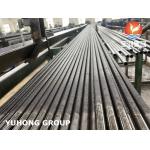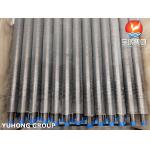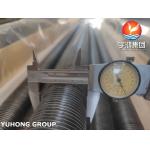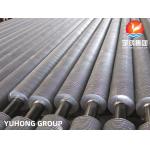ASTM A213 T9 ALLOY STEEL STUDDED FIN PIPE, 13CR STUD FOR FURNACE1. ASTM A213 T9 Alloy Steel- Material Standard: ASTM A213 T9 is a specification for seamless ferritic and
austenitic alloy steel tubes. It is commonly used for boiler,
superheater, and heat exchanger tubes, especially in applications
with elevated temperatures and pressures.
- Grade T9: This is a chromium-molybdenum alloy steel (9% Chromium and 1%
Molybdenum), which provides excellent resistance to oxidation,
high-temperature strength, and creep resistance. These
characteristics make T9 suitable for extreme conditions, such as
those found in furnaces and boilers.
2. Studded Fin Pipe- Purpose: A studded fin pipe has metal studs welded onto the pipe’s outer
surface. These studs act as fins, increasing the pipe’s surface
area to enhance heat transfer. This design is especially useful in
applications where there is a need for high efficiency in heat
transfer between the pipe and surrounding environment.
- Application in Furnaces: Studded pipes are used in furnaces where the increased surface
area allows for more effective heat transfer from the furnace to
the pipe, optimizing heating and energy efficiency.
3. 13Cr Studs- Material: The "13Cr" refers to 13% chromium alloy studs, a stainless steel
variant known for its corrosion resistance and durability at high
temperatures. 13Cr stainless steel is typically resistant to
oxidation and scaling, especially in elevated-temperature
environments.
- Stud Welding: The 13Cr studs are welded onto the T9 alloy steel pipe, providing
a strong bond that withstands high-temperature cycles without
detaching. The choice of 13Cr studs is ideal for furnace
applications where both heat resistance and durability are
critical.
- Enhanced Heat Transfer: The studs serve to extend the pipe’s effective surface area,
enhancing heat exchange and improving the overall efficiency of the
system. The durable connection also helps maintain efficiency over
extended periods in demanding conditions.
Advantages of ASTM A213 T9 Studded Fin Pipe with 13Cr Studs- High Temperature and Pressure Resistance: ASTM A213 T9 alloy steel is designed to perform in harsh
conditions, making it suitable for furnaces where high temperatures
and pressures are common.
- Improved Heat Transfer: The studded design maximizes surface area, leading to efficient
heat transfer, which is critical in furnace applications.
- Corrosion and Oxidation Resistance: The chromium content in both T9 alloy steel and 13Cr studs offers
excellent resistance to corrosion, oxidation, and scaling at high
temperatures.
- Durability and Mechanical Strength: The alloy steel pipe and high-strength studs ensure longevity and
minimal maintenance needs, even in environments with fluctuating
thermal cycles.
Applications 1. Furnaces in Petrochemical and Refinery Industries- Role: In petrochemical plants, furnaces are essential for heating raw
materials to start chemical reactions. The studded fin design
enhances the surface area for heat transfer, making these pipes
highly effective in maximizing energy use and controlling
temperature distribution.
- Benefit: The ASTM A213 T9 pipe's heat resistance and studded fins allow it
to handle intense heat while providing reliable and stable
performance. This stability is crucial in an industry where
precision and safety are always at the forefront.
2. Power Generation Boilers and Heat Exchangers- Role: These pipes are also commonly used in power plants, especially in
boiler systems where steam is generated at high temperatures. The
studded fins aid in transferring heat efficiently to the water,
enabling steady steam production.
- Benefit: For power plants aiming to operate efficiently and sustain high
output, the durability and heat transfer capabilities of the T9
studded fin pipes play an integral part in ensuring smooth,
efficient energy conversion processes.
3. Chemical Processing Furnaces- Role: Chemical processes often require carefully controlled heating to
ensure reactions occur as expected. The ASTM A213 T9 pipes, with
their chromium-molybdenum alloy, withstand intense heat and resist
corrosion in these high-demand environments.
- Benefit: Here, the high-temperature resistance and extended surface area
provided by the studded fins allow for precise temperature control,
reducing the risk of hot spots or temperature inconsistencies.
|









